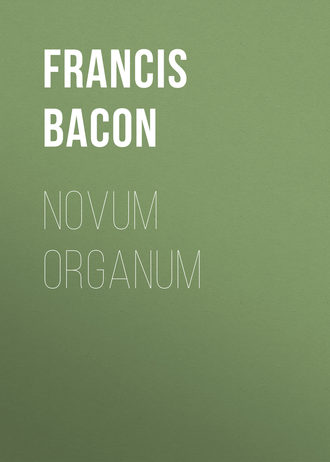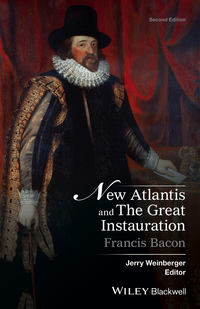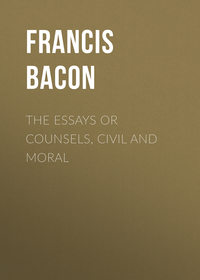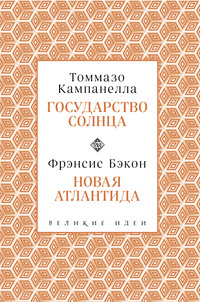 полная версия
полная версияNovum Organum
103
This is erroneous – all metals expand considerably when heated.
104
“Quid ipsum,” the τὸ τὶ ἦν εἶναι of Aristotle.
105
To show the error of the text, we need only mention the case of water, which, when confined in corked vases, and exposed to the action of a freezing atmosphere, is sure to swell out and break those vessels which are not sufficiently large to contain its expanded volume. Megalotti narrates a hundred other instances of a similar character. —Ed.
106
Bacon’s inquisition into the nature of heat, as an example of the mode of interpreting nature, cannot be looked upon otherwise than as a complete failure. Though the exact nature of this phenomenon is still an obscure and controverted matter, the science of thermotics now consists of many important truths, and to none of these truths is there so much as an approximation in Bacon’s process. The steps by which this science really advanced were the discovery of a measure of a heat or temperature, the establishment of the laws of conduction and radiation, of the laws of specific heat, latent heat, and the like. Such advances have led to Ampère’s hypothesis, that heat consists in the vibrations of an imponderable fluid; and to Laplace’s theory, that temperature consists in the internal radiation of a similar medium. These hypotheses cannot yet be said to be even probable, but at least they are so modified as to include some of the preceding laws which are firmly established, whereas Bacon’s “form,” or true definition of heat, as stated in the text, includes no laws of phenomena, explains no process, and is indeed itself an example of illicit generalization.
In all the details of his example of heat he is unfortunate. He includes in his collection of instances, the hot tastes of aromatic plants, the caustic effects of acids, and many other facts which cannot be ascribed to heat without a studious laxity in the use of the word. —Ed.
107
By this term Bacon understands general phenomena, taken in order from the great mass of indiscriminative facts, which, as they lie in nature, are apt to generate confusion by their number, indistinctness and complication. Such classes of phenomena, as being peculiarly suggestive of causation, he quaintly classes under the title of prerogative inquiries, either seduced by the fanciful analogy, which such instances bore to the prerogativa centuria in the Roman Comitia, or justly considering them as Herschel supposes to hold a kind of prerogative dignity from being peculiarly suggestive of causation.
Two high authorities in physical science (v. Herschel, Nat. Phil., art. 192; Whewell’s Philosophy of the Inductive Sciences, vol. ii. p. 243) pronounce these instances of little service in the task of induction, being for the most part classed not according to the ideas which they involve, or to any obvious circumstance in the facts of which they consist, but according to the extent and manner of their influence upon the inquiry in which they are employed. Thus we have solitary instances, migrating instances, ostensive instances, clandestine instances, so termed according to the degree in which they exhibit, or seem to exhibit, the property, whose nature we would examine. We have guide-post instances, crucial instances, instances of the parted road, of the doorway, of the lamp, according to the guidance they supply to our advance. Whewell remarks that such a classification is much of the same nature as if, having to teach the art of building, we were to describe tools with reference to the amount and place of the work which they must do, instead of pointing out their construction and use; as if we were to inform the pupil that we must have tools for lifting a stone up, tools for moving it sidewise, tools for laying it square, and tools for cementing it firmly. The means are thus lost in the end, and we reap the fruits of unmethodical arrangement in the confusion of cross division. In addition, all the instances are leavened with the error of confounding the laws with the causes of phenomena, and we are urged to adopt the fundamental error of seeking therein the universal agents, or general causes of phenomena, without ascending the gradual steps of intermediate laws. —Ed.
108
Of these nine general heads no more than the first is prosecuted by the author.
109
This very nearly approaches to Sir I. Newton’s discovery of the decomposition of light by the prism.
110
The mineral kingdom, as displaying the same nature in all its gradations, from the shells so perfect in structure in limestone to the finer marbles in which their nature gradually disappears, is the great theatre for instances of migration. —Ed.
111
Bacon was not aware of the fact since brought to light by Römer, that down to fourteen fathoms from the earth’s mean level the thermometer remains fixed at the tenth degree, but that as the thermometer descends below that depth the heat increases in a ratio proportionate to the descent, which happens with little variation in all climates. Buffon considers this a proof of a central fire in our planet. —Ed.
112
All the diversities of bodies depend upon two principles, i. e., the quantity and the position of the elements that enter into their composition. The primary difference is not that which depends on the greatest or least quantity of material elements, but that which depends on their position. It was the quick perception of this truth that made Leibnitz say that to complete mathematics it was necessary to join to the analysis of quantity the analysis of position. —Ed.
113
Query?
114
The real cause of this phenomenon is the attraction of the surface-water in the vessel by the sides of the bubbles. When the bubbles approach, the sides nearest each other both tend to raise the small space of water between them, and consequently less water is raised by each of these nearer sides than by the exterior part of the bubble, and the greater weight of the water raised on the exterior parts pushes the bubbles together. In the same manner a bubble near the side of a vessel is pushed toward it; the vessel and bubble both drawing the water that is between them. The latter phenomenon cannot be explained on Bacon’s hypothesis.
115
Modern discoveries appear to bear out the sagacity of Bacon’s remark, and the experiments of Baron Cagnard may be regarded as a first step toward its full demonstration. After the new facts elicited by that philosopher, there can be little doubt that the solid, liquid and aëriform state of bodies are merely stages in a progress of gradual transition from one extreme to the other, and that however strongly marked the distinctions between them may appear, they will ultimately turn out to be separated by no sudden or violent line of demarcation, but slide into each other by imperceptible gradations. Bacon’s suggestion, however, is as old as Pythagoras, and perhaps simultaneous with the first dawn of philosophic reason. The doctrine of the reciprocal transmutation of the elements underlies all the physical systems of the ancients, and was adopted by the Epicureans as well as the Stoics. Ovid opens his last book of the Metamorphoses with the poetry of the subject, where he expressly points to the hint of Bacon: —
– “Tenuatus in aurasAëraque humor abit, etc., etc.
Inde retro redeunt, idemque retexitur ordo.” – xv. 246–249.
and Seneca, in the third book of his Natural Philosophy, quest. iv., states the opinion in more precise language than either the ancient bard or the modern philosopher. —Ed.
116
The author’s own system of Memoria Technica may be found in the De Augmentis, chap. xv. We may add that, notwithstanding Bacon’s assertion that he intended his method to apply to religion, politics, and morals, this is the only lengthy illustration he has adduced of any subject out of the domain of physical science. —Ed.
117
The collective instances here meant are no other than general facts or laws of some degree of generality, and are themselves the result of induction. For example, the system of Jupiter, or Saturn with its satellites, is a collective instance, and materially assisted in securing the admission of the Copernican system. We have here in miniature, and displayed at one view, a system analogous to that of the planets about the sun, of which, from the circumstance of our being involved in it, and unfavorably situated for seeing it otherwise than in detail, we are incapacitated from forming a general idea, but by slow and progressive efforts of reason.
But there is a species of collective instance which Bacon does not seem to have contemplated, in which particular phenomena are presented in such numbers at once, as to make the induction of their law a matter of ocular inspection. For example, the parabolic form assumed by a jet of water spouted out of a hole is a collective instance of the velocities and directions of the motions of all the particles which compose it seen together, and which thus leads us without trouble to recognize the law of the motion of a projectile. Again, the beautiful figures exhibited by sand strewed on regular plates of glass or metal set in vibration, are collective instances of an infinite number of points which remain at rest while the remainder of the plate vibrates, and in consequence afford us an insight into the law which regulates their arrangement and sequence throughout the whole surface. The richly colored lemniscates seen around the optic axis of crystals exposed to polarized light afford a striking instance of the same kind, pointing at once to the general mathematical expression of the law which regulates their production. Such collective instances as these lead us to a general law by an induction which offers itself spontaneously, and thus furnish advanced posts in philosophical exploration. The laws of Kepler, which Bacon ignored on account of his want of mathematical taste, may be cited as a collective instance. The first is, that the planets move in elliptical orbits, having the sun for their common focus. The second, that about this focus the radius vector of each planet describes equal areas in equal times. The third, that the squares of the periodic times of the planets are as the cubes of their mean distance from the sun. This collective instance “opened the way” to the discovery of the Newtonian law of gravitation. —Ed.
118
Is not this very hasty generalization? Do serpents move with four folds only? Observe also the motion of centipedes and other insects.
119
Shaw states another point of difference between the objects cited in the text – animals having their roots within, while plants have theirs without; for their lacteals nearly correspond with the fibres of the roots in plants; so that animals seem nourished within themselves as plants are without. —Ed.
120
Bacon falls into an error here in regarding the syllogism as something distinct from the reasoning faculty, and only one of its forms. It is not generally true that the syllogism is only a form of reasoning by which we unite ideas which accord with the middle term. This agreement is not even essential to accurate syllogisms; when the relation of the two things compared to the third is one of equality or similitude, it of course follows that the two things compared may be pronounced equal, or like to each other. But if the relation between these terms exist in a different form, then it is not true that the two extremes stand in the same relation to each other as to the middle term. For instance, if A is double of B, and B double of C, then A is quadruple of C. But then the relation of A to C is different from that of A to B and of B to C. —Ed.
121
Comparative anatomy is full of analogies of this kind. Those between natural and artificial productions are well worthy of attention, and sometimes lead to important discoveries. By observing an analogy of this kind between the plan used in hydraulic engines for preventing the counter-current of a fluid, and a similar contrivance in the blood vessels, Harvey was led to the discovery of the circulation of the blood. —Ed.
122
This is well illustrated in plants, for the gardener can produce endless varieties of any known species, but can never produce a new species itself.
123
The discoveries of Tournefort have placed moss in the class of plants. The fish alluded to below are to be found only in the tropics. —Ed.
124
There is, however, no real approximation to birds in either the flying fish or bat, any more than a man approximates to a fish because he can swim. The wings of the flying fish and bat are mere expansions of skin, bearing no resemblance whatever to those of birds. —Ed.
125
Seneca was a sounder astronomer than Bacon. He ridiculed the idea of the motion of any heavenly bodies being irregular, and predicted that the day would come, when the laws which guided the revolution of these bodies would be proved to be identical with those which controlled the motions of the planets. The anticipation, was realized by Newton. —Ed.
126
But see Bacon’s own corollary at the end of the Instances of Divorce, Aphorism xxxvii. If Bacon’s remark be accepted, the censure will fall upon Newton and the system so generally received at the present day. It is, however, unjust, as the centre of which Newton so often speaks is not a point with an active inherent force, but only the result of all the particular and reciprocal attractions of the different parts of the planet acting upon one spot. It is evident, that if all these forces were united in this centre, that the sum would be equal to all their partial effects. —Ed.
127
Since Newton’s discovery of the law of gravitation, we find that the attractive force of the earth must extend to an infinite distance. Bacon himself alludes to the operation of this attractive force at great distances in the Instances of the Rod, Aphorism xlv.
128
Snow reflects light, but is not a source of light.
129
Bacon’s sagacity here foreshadows Newton’s theory of the tides.
130
The error in the text arose from Bacon’s impression that the earth was immovable. It is evident, since gravitation acts at an infinite distance, that no such point could be found; and even supposing the impossible point of equilibrium discovered, the body could not maintain its position an instant, but would be hurried, at the first movement of the heavenly bodies, in the direction of the dominant gravitating power. —Ed.
131
Fly clocks are referred to in the text, not pendulum clocks, which were not known in England till 1662. The former, though clumsy and rude in their construction, still embodied sound mechanical principles. The comparison of the effect of a spring with that of a weight in producing certain motions in certain times on altitudes and in mines, has recently been tried by Professors Airy and Whewell in Dalcoath mine, by means of a pendulum, which is only a weight moved by gravity, and a chronometer balance moved and regulated by a spring. In his thirty-seventh Aphorism, Bacon also speaks of gravity as an incorporeal power, acting at a distance, and requiring time for its transmission; a consideration which occurred at a later period to Laplace in one of his most delicate investigations.
Crucial instances, as Herschel remarks, afford the readiest and securest means of eliminating extraneous causes, and deciding between the claims of rival hypotheses; especially when these, running parallel to each other, in the explanation of great classes of phenomena, at length come to be placed at issue upon a single fact. A curious example is given by M. Fresnel, as decisive in his mind of the question between the two great theories on the nature of light, which, since the time of Newton and Huyghens, have divided philosophers. When two very clean glasses are laid one on the other, if they be not perfectly flat, but one or both, in an almost imperceptible degree, convex or prominent, beautiful and vivid colors will be seen between them; and if these be viewed through a red glass, their appearance will be that of alternate dark and bright stripes. These stripes are formed between the two surfaces in apparent contact, and being applicable on both theories, are appealed to by their respective supporters as strong confirmatory facts; but there is a difference in one circumstance, according as one or other theory is employed to explain them. In the case of the Huyghenian theory, the intervals between the bright stripes ought to appear absolutely black, when a prism is used for the upper glass, in the other half bright. This curious case of difference was tried, as soon as the opposing consequences of the two theories were noted by M. Fresnel, and the result is stated by him to be decisive in favor of that theory which makes light to consist in the vibrations of an elastic medium. —Ed.
132
Bacon plainly, from this passage, was inclined to believe that the moon, like the comets, was nothing more than illuminated vapor. The Newtonian law, however, has not only established its solidity, but its density and weight. A sufficient proof of the former is afforded by the attraction of the sea, and the moon’s motion round the earth. —Ed.
133
Rather the refraction; the sky or air, however, reflects the blue rays of light.
134
The polished surface of the glass causes the reflection in this case, and not the air; and a hat or other black surface put behind the window in the daytime will enable the glass to reflect distinctly for the same reason, namely, that the reflected rays are not mixed and confused with those transmitted from the other side of the window.
135
These instances, which Bacon seems to consider as a great discovery, are nothing more than disjunctive propositions combined with dilemmas. In proposing to explain an effect, we commence with the enumeration of the different causes which seem connected with its production; then with the aid of one or more dilemmas, we eliminate each of the phenomena accidental to its composition, and conclude with attributing the effect to the residue. For instance, a certain phenomenon (a) is produced either by phenomenon (B) or phenomenon (C); but C cannot be the cause of a, for it is found in D, E, F, neither of which are connected with a. Then the true cause of phenomenon (a) must be phenomenon (B).
This species of reasoning is liable to several paralogisms, against which Bacon has not guarded his readers, from the very fact that he stumbled into them unwittingly himself. The two principal ones are false exclusions and defective enumerations. Bacon, in his survey of the causes which are able to concur in producing the phenomena of the tides, takes no account of the periodic melting of the Polar ice, or the expansion of water by the solar heat; nor does he fare better in his exclusions. For the attraction of the planets and the progression and retrograde motion communicated by the earth’s diurnal revolution, can plainly affect the sea together, and have a simultaneous influence on its surface.
Bacon is hardly just or consistent in his censure of Ramus; the end of whose dichotomy was only to render reasoning by dilemma, and crucial instances, more certain in their results, by reducing the divisions which composed their parts to two sets of contradictory propositions. The affirmative or negative of one would then necessarily have led to the acceptance or rejection of the other. —Ed.
136
Père Shenier first pointed out the spots on the sun’s disk, and by the marks which they afforded him, computed its revolution to be performed in twenty-five days and some hours. —Ed.
137
Rust is now well known to be a chemical combination of oxygen with the metal, and the metal when rusty acquires additional weight. His theory as to the generation of animals, is deduced from the erroneous notion of the possibility of spontaneous generation (as it was termed). See the next paragraph but one.
138
“Limus ut hic durescit, et hæc ut cera liquescit
Uno eodemque igni.” – Virg. Ecl. viii.
139
See Table of Degrees, No. 38.
140
Riccati, and all modern physicists, discover some portion of light in every body, which seems to confirm the passage in Genesis that assigns to this substance priority in creation. —Ed.
141
As instances of this kind, which the progress of science since the time of Bacon affords, we may cite the air-pump and the barometer, for manifesting the weight and elasticity of air: the measurement of the velocity of light, by means of the occultation of Jupiter’s satellites and the aberration of the fixed stars: the experiments in electricity and galvanism, and in the greater part of pneumatic chemistry. In all these cases scientific facts are elicited, which sense could never have revealed to us. —Ed.
142
The itinerant instances, as well as frontier instances, are cases in which we are enabled to trace the general law of continuity which seems to pervade all nature, and which has been aptly embodied in the sentence, “natura non agit per saltum.” The pursuit of this law into phenomena where its application is not at first sight obvious, has opened a mine of physical discovery, and led us to perceive an intimate connection between facts which at first seemed hostile to each other. For example, the transparency of gold-leaf, which permits a bluish-green light to pass through it, is a frontier instance between transparent and opaque bodies, by exhibiting a body of the glass generally regarded the most opaque in nature, as still possessed of some slight degree of transparency. It thus proves that the quality of opacity is not a contrary or antagonistic quality to that of transparency, but only its extreme lowest degree.
143
Alluding to his theory of atoms.
144
Observe the approximation to Newton’s theory. The same notion repeated still more clearly in the ninth motion. Newton believed that the planets might so conspire as to derange the earth’s annual revolution, and to elongate the line of the apsides and ellipsis that the earth describes in its annual revolution round the sun. In the supposition that all the planets meet on the same straight line, Venus and Mercury on one side of the sun, and the earth, moon, Mars, Jupiter and Saturn on the side diametrically opposite; then Saturn would attract Jupiter, Jupiter Mars, Mars the moon, which must in its turn attract the earth in proportion to the force with which it was drawn out of its orbit. The result of this combined action on our planet would elongate its ecliptic orbit, and so far draw it from the source of heat, as to produce an intensity of cold destructive to animal life. But this movement would immediately cease with the planetary concurrence which produced it, and the earth, like a compressed spring, bound almost as near to the sun as she had been drawn from it, the reaction of the heat on its surface being about as intense as the cold caused by the first removal was severe. The earth, until it gained its regular track, would thus alternately vibrate between each side of its orbit, with successive changes in its atmosphere, proportional to the square of the variation of its distance from the sun. In no place is Bacon’s genius more conspicuous than in these repeated guesses at truth. He would have been a strong Copernican, had not Gilbert defended the system. —Ed.








